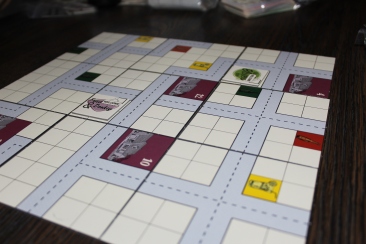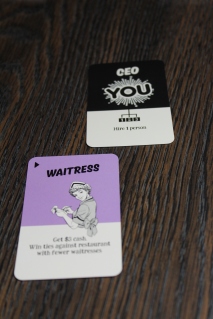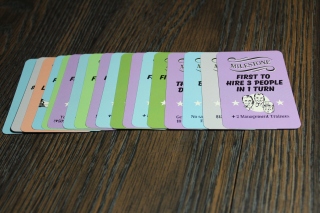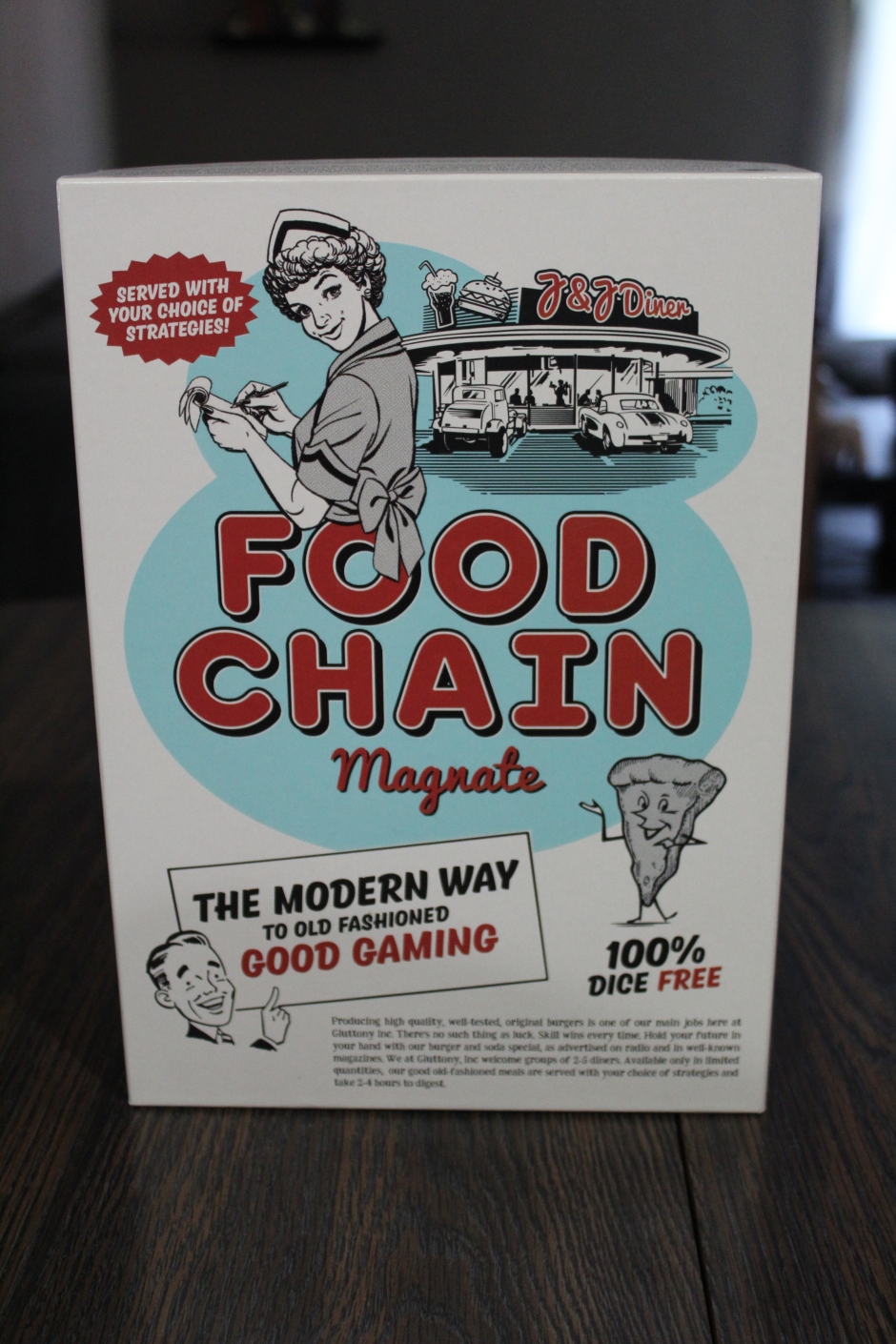Overview
Quick Facts
Designer: Jeroen Doumen, Joris Wiersinga
Genre: Economic, Manufacturing
Players: 2-5
Time: ~45 minutes per player
It’s the 1950s, and fast food is the latest craze. Nothing gets the families of small-town suburbia out of their houses like the promise of hot food and cold drinks, served almost instantly. You can see this new market starting to form and decide to start up your own restaurant chain, planning on making bank selling to hungry (and lazy) people. However, you’re not the only one with this brilliant idea, as several other competing chains have started up in your very same small town! Now, you must out-produce, out-advertise, or out-price your opponents out of the market and make your way to the top of the food chain!
Food Chain Magnate is a very heavy strategic game where players build up a fast food franchise starting with just one restaurant and a CEO. You will then need to hire more employees to begin producing food and drinks, advertising your products, and selling to the customers in town. The player who makes the most money by the end of the game can truly call themselves a food chain magnate!
Gameplay
The only randomness that ever factors into a game of Food Chain Magnate happens at the very beginning — building the board. The modular map tiles are shuffled and dealt out randomly to make a board size corresponding to the number of players: 3×3, 3×4, 4×4, or 4×5 corresponding to 2, 3, 4, or 5 players, respectively.  Each player chooses a restaurant franchise to play as and places one of their restaurants out on the board with the door adjacent to a road. Then the bank fills up with $50 per player, and each player secretly submits a reserve card representing how much money the bank will be refilled with once it runs out, either $100, $200, or $300. Finally, each player begins with a CEO And no money), and the game is ready to begin!
Each player chooses a restaurant franchise to play as and places one of their restaurants out on the board with the door adjacent to a road. Then the bank fills up with $50 per player, and each player secretly submits a reserve card representing how much money the bank will be refilled with once it runs out, either $100, $200, or $300. Finally, each player begins with a CEO And no money), and the game is ready to begin!
Food Chain Magnate is played over a series of rounds. Each turn, players decide which of their employees will be in play that day. Everyone starts with just their CEO, who can have up to three people working under them, but can hire middle managers who allow players to have use more of their workers each turn. Once everyone has decided which of their workers will be in play, they place their workers into an organizational structure under their managers. Turn order is decided by who has the most available employee slots under their managers. Then, in turn order players can take actions for all of their working employees for that round.
Each of the 32 different types of employee cards have their own unique actions they can take, but they generally fall under only a few different categories.  Recruiting lets you hire new entry-level employees to your business (and since your CEO can recruit and must always be in play, you’ll always get the opportunity to hire at least one new employee per turn). Training lets you upgrade one of your employees that isn’t working that day into a higher level with a more powerful ability. Marketing lets you place out various types of ad campaigns (billboards, mailbox, airplane, or radio) that generate demand for a particular type of food or drink on affected houses on the board. Cooks can produce either burgers or pizza for your restaurant, while drink buyers drive around on the roads, picking up soda, lemonade, or beer as they pass the icons where they’re distributed. Finally, some employees allow you to build new houses in the town, upgrade existing houses with gardens (which makes the residents pay more for their food — they’re rich enough to have a garden, after all!) or build a new franchise of your restaurant.
Recruiting lets you hire new entry-level employees to your business (and since your CEO can recruit and must always be in play, you’ll always get the opportunity to hire at least one new employee per turn). Training lets you upgrade one of your employees that isn’t working that day into a higher level with a more powerful ability. Marketing lets you place out various types of ad campaigns (billboards, mailbox, airplane, or radio) that generate demand for a particular type of food or drink on affected houses on the board. Cooks can produce either burgers or pizza for your restaurant, while drink buyers drive around on the roads, picking up soda, lemonade, or beer as they pass the icons where they’re distributed. Finally, some employees allow you to build new houses in the town, upgrade existing houses with gardens (which makes the residents pay more for their food — they’re rich enough to have a garden, after all!) or build a new franchise of your restaurant.
After all players have carried out all of their actions, it’s time to eat! All houses that have demand for food or drinks (which is generated in a later step) go out in search of nourishment. Each house will go to a restaurant that can serve them everything they’re looking for, so if they want two pizzas and a beer and you only have pizza and soda, you can’t partially serve them. If there are multiple restaurants that can satisfy a demand, the decision will be made based on distance and price, so employees that can lower your prices are very useful to snag business away from your competitors!  Each food or drink item you can serve gets you a base of $10, which can be modified either up or down by employees or other bonuses. After all of the houses have been served (or not, if there were no restaurants that could meet their demand), everyone must pay all of their upgraded (non-entry level) workers a wage of $5, firing employees if you can’t or don’t want to pay them. Finally, all active marketing campaigns take effect, adding demand to the houses they influence. Billboards affect only houses they touch, mailbox campaigns affect houses enclosed in one block, airplane campaigns affect all houses in a particular row or rows on the board, and radio campaigns affect everything within a 3×3 grid of map tiles. All advertising campaigns take effect in numerical order, so if a house has maximum demand already (3 items, or 5 if the house has a garden) they may not be affected by a particular campaign, so you’ve got to plan accordingly!
Each food or drink item you can serve gets you a base of $10, which can be modified either up or down by employees or other bonuses. After all of the houses have been served (or not, if there were no restaurants that could meet their demand), everyone must pay all of their upgraded (non-entry level) workers a wage of $5, firing employees if you can’t or don’t want to pay them. Finally, all active marketing campaigns take effect, adding demand to the houses they influence. Billboards affect only houses they touch, mailbox campaigns affect houses enclosed in one block, airplane campaigns affect all houses in a particular row or rows on the board, and radio campaigns affect everything within a 3×3 grid of map tiles. All advertising campaigns take effect in numerical order, so if a house has maximum demand already (3 items, or 5 if the house has a garden) they may not be affected by a particular campaign, so you’ve got to plan accordingly!
 One of the most important aspects of the game is milestones. These are cards representing various objectives players can achieve throughout the course of the game. The first player (or players, if multiple people achieve it on the same turn) get the milestone card along with a related bonus for the rest of the game. For instance, by being the first player to market pizza, burgers, or drinks, you will gain an additional $5 when selling that item for the rest of the game. These milestone powers can be very powerful, and should not be ignored. The path to victory will be a very difficult without a few milestones working in synergy.
One of the most important aspects of the game is milestones. These are cards representing various objectives players can achieve throughout the course of the game. The first player (or players, if multiple people achieve it on the same turn) get the milestone card along with a related bonus for the rest of the game. For instance, by being the first player to market pizza, burgers, or drinks, you will gain an additional $5 when selling that item for the rest of the game. These milestone powers can be very powerful, and should not be ignored. The path to victory will be a very difficult without a few milestones working in synergy.
The game continues, with everyone taking turns playing out employees and taking actions (and hopefully making money) until the bank runs out of cash. At this point, the reserve cards each player selected at the beginning of the game are revealed, adding an additional $100-300 to the bank per player. The game resumes as before, going until the bank again runs out of money, at which point it is over and the person with the most money wins!
Amber’s Review
Theme & Integration: 8
Components & Artwork: 6
Scalability: 8
Fun Factor: 9
Overall: 8.2/10
“A serious game for serious gamers.” They’re not kidding. Like, totally not kidding. One reason why this game was my “grail game” for so long is because this game touted itself as exactly that and I wanted a game where my skills were what paid the bills. When you open the box, it doesn’t really seem like much; there are a ton of cards, some modular city tiles, and food components. The art on the game serves its purpose, but it doesn’t do any more than that. It doesn’t have to be fancy or over the top, we’re not slaying dragons or saving the world. We’re hocking food here, people. The art lends itself to the “serious game for serious gamers.”
The first time we played this game, the set up was a bit overwhelming, not in that there were a ton of things to set up (really, you only need to set up your tiles and starting restaurants) but you need SO MUCH ROOM to lay the cards out for everyone to see! And since our first time playing was in a hotel room at GenCon, this lead to some creative card displaying. I recommend that if you plan on buying this game, you also invest in the card accordion to help keep the game organized. I promise you it’ll be the best $13 you ever spend (on game organization).
The game mechanics are pretty straightforward, your turn actions are limited by what workers you play, so you should be aware of what will be happening on your turn right from the start. The tricky part is making sure that you are making no mistakes. I wish I was kidding about this part, but this game is a cruel mistress. If you’re not paying attention to what the other players around you are doing, and you have a plan on what you’d like to do, that plan might be over in a snap. And good luck digging yourself out of a hole, because there is no catch up mechanic. In the game of restaurants, you either win or you dine. In someone else’s restaurant. Because yours closed.
- Pros:
- Plays well with 2-4
- Easy setup
- Straightforward gameplay
- Cons:
- Can be AP (Analysis Paralysis) prone
- PLEASE DO NOT TRY WITH FIVE PLAYERS
Ethan’s Review
Theme & Integration: 8
Components & Artwork: 7
Scalability: 8
Fun Factor: 9
Overall: 8.4/10
Food Chain Magnate bills itself as a very heavy, strategic game — in no fewer than three places on the box and in the rules does it emphasize that it’s a serious game for serious gamers. While maybe a bit overblown, it’s not entirely inaccurate. While not entirely complex mechanics-wise (most of the employee actions are pretty straightforward), it is a strategically complex and unforgiving game. You need to think about the available milestones, the board layout and state, what your opponents are doing (and could be planning to do), and integrate that all into a plan of what you need to do. The only randomness in Food Chain Magnate is the board setup and turn order for the first round. After that, everything is based on what you and the other players, which is part of why I like this game so much. The mechanics are very tight and balanced, and actually make sense with the theme. The employee’s actions all make sense, and they follow a logical path of promotion. Likewise, the milestones are pretty thematic as well — if you’re the first to market a burger, you make more money from it because you can advertise that you’re the original burger joint in town. Component-wise, Food Chain Magnate isn’t anything too special. The wooden tokens for the different food and drink types are nice (although for some reason in the first edition of the rules, the yellow drinks were referred to as orange juice, which has since been updated to lemonade), but other than that there really isn’t anything fancy. I really wish they would have had something other than paper money — many other games have found great success with little money-shaped cardboard tokens, and for roughly $100, I wish FCM could have done something similar. I really do like the artwork though — it’s a bit minimalistic, but reminiscent of a 50’s diner style, which makes sense with the game’s theme. We’ve played the game with 2 and 4 players, and while the dynamics of the game are different between the player counts, the core game manages to feel the same. With two players, you really have to watch what your opponent is doing and plan accordingly, or else you can get steamrolled by them forming a monopoly on a certain type of food and then jacking up the price for major profits each round. On the other hand, with more players you have to pay attention to everyone and be adaptable to what the other players may be trying to do. Also with more people you’re more likely to find yourself in a price war of trying to lower your prices in order to sell, which may end up hurting you more than it helps the other players. Regardless, at all player counts Food Chain Magnate can end up being a tight, tense race to the top of the food chain as you try to outmaneuver your opponents with timing, marketing, and careful production of food and drinks. If you’re looking for a deep, strategic game, I can’t recommend Food Chain Magnate highly enough.
- Pros:
- Virtually no luck, all strategy.
- Very solid game mechanically and gameplay-wise, with gameplay that matches up with its theme very well.
- Cons:
- Game is very unforgiving — if you make a mistake it is very hard to catch up.
- Prone to analysis paralysis, especially with more players.
- Component quality could be a bit better for the price tag.





